Disinfection means the destruction or removal of all pathogenic organisms, organisms capable of giving rise to infection [1,2]. In Prosthodontics, objects potentially contaminated with pathogenic microorganisms are transported between the dental clinic to laboratory [3] and because any individual visiting the dental clinic is vulnerable to cross-infection and it is mandatory to prevent cross-contamination during every clinical and laboratory procedure.
Occupational Safety and Health Association (OSHA) guidelines (1991) requires dentists, dental laboratory employers and other employers in health care fields to provide protection for their employees against the possibility of infection transmission but OSHA sub-section that relates to dentistry does not specify the process to eliminate potentially infectious organisms that come in contact with the oral cavity or body fluids [4]. Adequate care needs to be taken to prevent the carriage and transmission of microorganisms that come in contact with oral fluids and blood and should pass through specific disinfection process before being handled by other staff or laboratory personnel. Among the issues to be resolved are the composition and concentration of the ideal chemical disinfectant, optimal exposure time and the interaction between impression materials and disinfectant solutions [5].
From the dental laboratory point of view, a more practical approach would be to wash the impression of visible contaminants such as blood and saliva, pour the stone cast and then sterilize the cast [6]. Some manufacturers have added disinfectants to dental gypsum to decrease cross-contamination. One major concern regarding infection control is the effect of disinfection of dental impression materials and, concerns exist regarding any chemical interaction between this impression complex and the disinfectant solution and the effects of such interaction on the resultant models [4].Dimensional stability is defined as the ability of a material to retain its size and form and require for exact replication of dies and prosthesis made on the cast [6]. It is important that disinfectant solutions be effective as antimicrobial agents, but not depreciate the physical property of gypsum cast or significantly alter the accuracy of the casts [7]. All chemical disinfectants may be potentially harmful to the health of the user, which necessitates careful handling. Conventional autoclaving could easily damage the surface of dental stone due to the high temperature (greater than 120°C).
Gas sterilization is costly and time consuming. Microwave sterilization may be an alternative that might prove to be a more viable option for sterilizing dental stone casts and thus needs to be thoroughly investigated [5].The microwave oven has been suggested by researchers at the University of Florida to rapidly and effectively sterilize kitchen sponges and plastic scrubbers; known to be common carriers of bacteria and viruses that cause food-borne illnesses [8,9]. The aims and objective of the present in-vitro study is to compare microwave irradiation and 0.07% sodium hypochlorite chemical disinfection and their effect on the dimensional stability of Kala stone casts/discs. Keeping all the above points into view the present study was conducted with the following aims and objectives to compare microwave and chemical disinfection and to evaluate the effect of microwave irradiation and chemical disinfection on the dimensional stability of dental stone casts/discs.
Materials and Methods
The study was conducted in Kothiwal Dental College, Moradabad for a period of six months in the Departments of Prosthodontics and Oral Pathology & Microbiology.
Comparison between microwave irradiation and chemical disinfection
Microwave irradiation and 0.07% sodium hypochlorite chemical disinfection were compared by making forty impressions of a sterile metal dying. The metallic die was made sterile by autoclaving for 15 lbs pressure at 1210C for 15 minutes. The impressions of metallic die were made by mixing Zelgan 2002 according to the manufacturer’s instructions and loaded onto a stainless steel perforated rim lock tray. These forty impressions were divided into two groups of 20 each. Each group was contaminated with Staphylococcus aureus and Pseudomonas aeruginosa respectively. Colonies of Staphylococcus aureus were obtained from its pure culture with an inoculation loop which was preheated and gradually allowed to cool, and transferred to test tubes containing 1ml of normal saline. Each test tube containing the suspension of Staphylococcus aureus was spread over the each Zelgan 2002 impression to contaminate the impression surface. After 7 minutes, excess suspension was shaken off. Two sterile aluminium plates were embedded into the impression surface to divide the impression into three parts; the impression was then poured in Kalstone and allowed to set for 1 hour. Each section was marked as A, B, C in each impression for identification. The same procedure was carried to contaminate twenty impressions with Pseudomonas aeruginosa. Total 40 infected casts, with marking A, B, C were retrieved and divided into 3 groups-
Group-1- Part A of 20 Kalstone casts were used for microwave disinfection by placing on a sterilized plate in household microwave oven and irradiate at 2450 MHZ, 900 W for 150 seconds. The stone casts were then reversed to irradiate the other part of the cast for another 150 seconds.
Group-2- Part B of twenty Kalstone casts were used for chemical disinfection by immersing in 0.07% sodium hypochlorite solution for ten minutes.
Group-3- Part C of 20 Kalstone casts were used as a control group which was neither treated with microwave nor treated with chemical disinfection.
A suspension was made by mixing three grams of Soyabean Casein Digest Broth in 100 ml of distilled water in a sterile glass beaker. The solution was heated to facilitate the proper mixing of the powder and was autoclaved under 15 lbs pressure at 1210C for 15 minutes. The liquid was then allowed to gradually cool down to room temperature. The 1.2 ml of suspension was poured into sixty sterile test tubes. Surfaces of Kalstone cast of group 1, 2, 3 were scraped off with a sterile B.P. knife and these scrapings were dropped into 60 test tubes containing Soyabean Digest Broth. The same procedure was repeated to prepare another sixty test tubes with suspension of Pseudomonas aeruginosa.The 120 test tubes of Soyabean Digest Broth were then placed in an incubator at 37°C for six hours.
For the development of the colony on agar plate a suspension was made by mixing four grams of Soyabean Agar Veg powder in 100 ml of distilled water in a sterile glass beaker. The solution was heated to facilitate the proper mixing of the powder and was autoclaved under 15 lbs pressure at 1210C for 15 minutes. The liquid was then allowed to cool down to room temperature. The suspension was poured into a sterile disposable Petri dish and was covered with a lid for 4 hours. Once the liquid solidified after slow and gradual cooling in the closed Petri dish, it was preserved in a deep freezer for six hours. The inoculation loop was preheated and allowed to gradually cool and then dipped in the test tubes containing scrapings and streaked on the agar culture plate. The procedure was carried out for 120 test tubes. The plates were placed in the incubator for 18 hours to allow growth of bacterial colonies [Table/Fig-1,2,3,4,5and6]. The colonies were then counted with the help of bacterial cell colony measuring counter.
Colonies of Staphylococcus aureus of control group
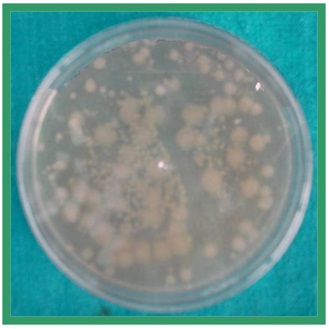
Colonies of Staphylococcus aureus of chemical disinfection group
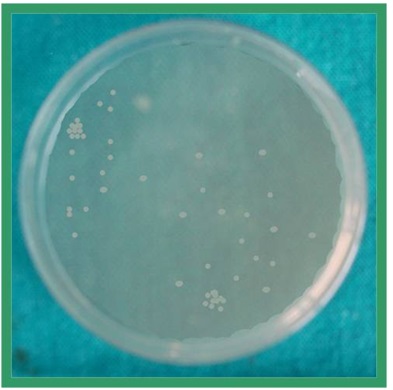
Colonies of Staphylococcus aureus of microwave irradiation group
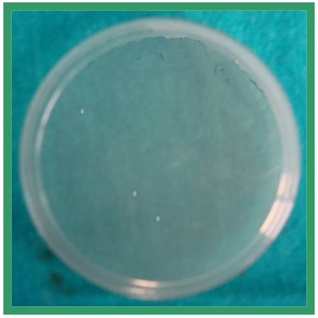
Colonies of Pseudomonas aeruginosa of control group
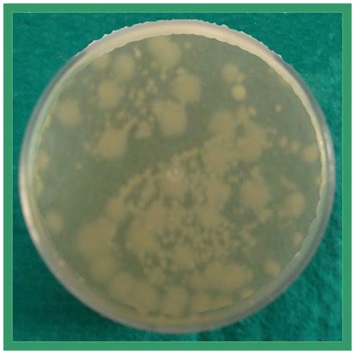
Colonies of Pseudomonas aeruginosa of chemical disinfection group
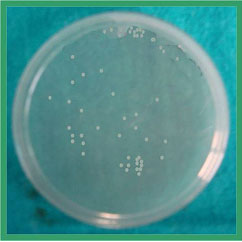
Colonies of Pseudomonas aeruginosa of microwave irradiation group
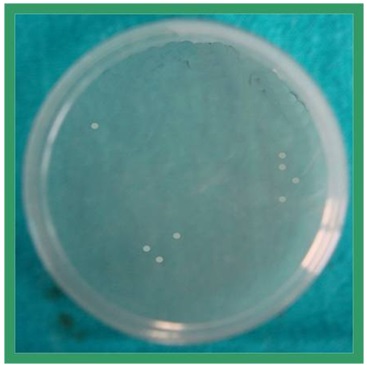
Method to evaluate dimensional stability
Fabrication of the mould.
According to ADA specification no. 19, a solid cylinder of aluminium with 31mm height was made which had three parts-
Part A- Ruled aluminium block
Part B- Metal collar
Part C- Riser
The outer diameter of the aluminium block was 38mm and inner diameter 30 mm. On this inner surface three parallel lines X, Y and Z were engraved, 2.5mm apart from each other, with line Y passing through the centre denoting the diameter of the circular surface. Two lines (cd and c’d’) were engraved perpendicular to the Y line such that cd and c’d’ were equidistant from the centre and 25mm apart from each other. The intersection of line cd and line Y was denoted as Point A and that of the line c’d’ and Y as point B as shown in the [Table/Fig-7]. When the metal collar was placed over the test surface of the aluminium block, a mold cavity was observed measuring 30mm in diameter and 2.5 mm in depth which would be the dimensions of test specimen.
Method to evaluate dimensional stability
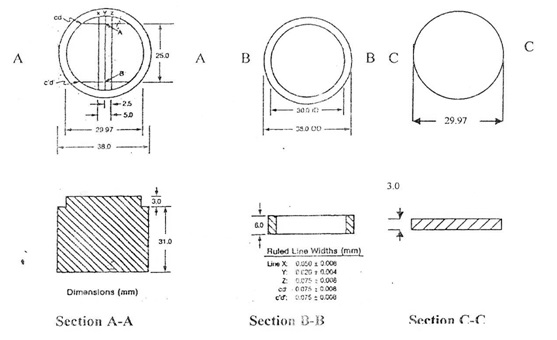
Preparation of test specimens
The aluminium block was used to prepare test specimens of Kala stone for the purpose of the study. The aluminium block and the metal collar were lubricated with white petroleum jelly except the ruled surface to allow accurate reproduction of the said markings. The ruled surface was cleaned with 70% ethyl alcohol to remove any foreign material. Seventy five discs of Kala stone were made by manually mixing of Kala stone with distilled water using 0.30 water/powder ratio in air conditioned room at a temperature of 20°C. This mixed was vibrated on to the mould cavity and covered by a glass plate under firm pressure to smoothen the surface and left undisturbed for 1 hour. Seventy five discs of Kala stone were retrieved with the help of riser without damaging the markings reproduced on the surface of discs. Twenty five discs were dipped in 0.07% sodium hypochlorite chemical disinfectant for ten minutes. Twenty five Kala stone discs were irradiated in microwave oven for five minutes as described in the section - 1 of the study and twenty five discs were left untreated for the control group. The dimensional change was evaluated under travelling microscope at 30 x magnifications. The specimen was placed under the eyepiece and distance between the cross lines CD& c’d’ and was measured and then recorded. Dimensional changes were calculated. The data obtained was statistically analysed.
The statistical analysis was done using SPSS (Statistical Package for Social Sciences) Version 15.0 statistical Analysis Software. Chi- square test and Wilcoxon signed rank were used in the study.
Results
In all the samples of Microwave the number of colonies ranged from 0 to 10. In terms of exponential power of 10, 19 values were 100 and only 1 value was depicted as 101. In chemically-treated specimen there were 5 specimens with 101, 14 with 102 and 1 specimen with 103 microbial load. On comparing the data statistically, a significant difference was seen (Z=56.480; p<0.001) [Table/Fig-8].
Assess the presence of microbial load i.e. Staphylococcus aureus colony in control group and after disinfection, via microwave and 0.07% sodium hypochlorite chemical disinfectant group Z=56.480; p<0.001 (Wilcoxon signed rank test)
| S. NO. | Level of Microbial load | Number of Specimens |
|---|
| Control | Microwave | 0.07% sodium hypochlorite |
|---|
| n | % | No. | % | n | % |
|---|
| 1. | 100 | 0 | 0 | 19 | 95 | 0 | 0 |
| 2. | 101 | 0 | 0 | 1 | 5 | 5 | 25 |
| 3. | 102 | 0 | 0 | 0 | 0 | 14 | 70 |
| 4. | 103 | 0 | 0 | 0 | 0 | 1 | 5 |
| 5. | 104 | 0 | 0 | 0 | 0 | 0 | 0 |
| 6. | 105 | 0 | 0 | 0 | 0 | 0 | 0 |
| Median rank | 106 | 100 | 102 |
Multiple comparisons revealed that there is a significant difference between all the three combinations on observing the microbial load of Staphylococcus aureus (p<0.001) [Table/Fig-9].
Multiple Comparisonsof three groups (control, 0.07% sodium hypochlorite chemical disinfection & microwave irradiation) of Staphylococcus aureus
| S.No. | Comparison | Z | p |
|---|
| 1. | Control vs Microwave | 6.102 | <0.001 |
| 2. | Control vs Chemical | 5.873 | <0.001 |
| 3. | Chemical vs Microwave | 5.805 | <0.001 |
On assessing the presence of microbial load i.e. Pseudomonas aeruginosa colony a statistically significant difference was observed (Z=57.833; p<0.001) [Table/Fig-10].
To assess the presence of microbial load i.e. Pseudomonas aeruginosa colony in control group and after disinfection, via microwave irradiated and 0.07% sodium hypochlorite chemical disinfectant group
Z=57.833; p<0.001 (Wilcoxon signed rank test)
| S. NO. | Level of Microbial load | Number of Specimens |
|---|
| Control | Microwave irradiated | 0.07% sodium hypochlorite |
|---|
| n | % | n | % | n | % |
|---|
| 1. | 100 | 0 | 0 | 20 | 100 | 0 | 0 |
| 2. | 101 | 0 | 0 | 0 | 0 | 1 | 5 |
| 3. | 102 | 0 | 0 | 0 | 0 | 16 | 80 |
| 4. | 103 | 0 | 0 | 0 | 0 | 3 | 15 |
| 5. | 104 | 0 | 0 | 0 | 0 | 0 | 0 |
| 6. | 105 | 0 | 0 | 0 | 0 | 0 | 0 |
| 7. | 106 | 20 | 100 | 0 | 0 | 0 | 0 |
| Median rank | 106 | 100 | 102 |
Multiple comparisons revealed a statistically significant (p<0.001) difference for all the three combinations on assessing the microbial load of Pseudomonas aeruginosa. On the basis of observations made for the microbial assessment the order of efficacy obtained was Microwave > Chemical > Control [Table/Fig-11].
Multiple Comparisons of three groups (control, 0.07% sodium hypochlorite chemical disinfectant & microwave irradiation) of Pseudomonas aeruginosa
| S. No. | Comparison | Z | p |
|---|
| 1. | Control vs Microwave | 6.245 | <0.001 |
| 2. | Control vs Chemical | 6.007 | <0.001 |
| 3. | Chemical vs Microwave | 6.007 | <0.001 |
The mean difference of control group was 25.0127, and the microwave irradiated group was 25.0136, and 0.07% chemical disinfectant was 25.0144 [Table/Fig-12].
Comparison of dimensional stability amongst the three groups i.e. microwave irradiated,0.07% sodium hypochlorite chemical treated and control group
| Group | Mean Difference |
|---|
| Control | 25.0127 |
| Microwave | 25.0136 |
| Chemical Disinfectant | 25.0144 |
The difference in mean dimension as compared to control group did not show a statistically significant difference between a microwave and chemical treated specimen as t=0.568; p=0.573.The t-value 0.568, denote no significant difference between a microwave and chemical group. Similarly the p value was 0.573 which denotes that there is no statistically significant difference between microwave and chemical treated specimen [Table/Fig-13].
Comparison of Difference in mean dimension as compared to control group in two groups (in mm)
| S.No. | Variable | Microwave | Chemical |
|---|
| 1. | Mean dimension | 25.0136 | 25.0144 |
| 2. | SD | 0.0049 | 0.0051 |
| 3. | Mean difference from control | 0.0036 | 0.0144 |
| 4. | Comparison of difference | t=0.568; p=0.573 |
Discussion
This study has been done to assess cross-contamination between the dentist and laboratory personnel because the large number of contaminated impressions and costs are transferred from the dental office to the laboratory. Microwave irradiation and chemical disinfection methods were compared using an in-vitro design against two microbial species i.e. Staphylococcus aureus and Pseudomonas aeruginosa similar to previous studies [9]. Suspensions of Staphylococcus aureus and Pseudomonas aeruginosa, which are opportunistic pathogens are transiently found in the oral cavity and easily transferred to the surface of the impression and further on the casts [10,11] were spread over the impression surface for contamination of impression.
Part A of the Kala stone cast was placed on the plate in household microwave oven because it is an effective disinfectant measure, used in the cycle of 900 W and 2450 MHz for 5 minutes because in the previous studies [12], workers stated that the vegetative bacteria were promptly killed in 5 minutes or less [12].
Part B of Kala stone casts were dipped in 0.07% concentration of sodium hypochlorite for ten minutes because it is a clinically accepted disinfectant which effectively reduces the number of bacteria as stated in various studies [3,10,12–15].
The microbial growth was assessed using standard equipment and technique as stated by Ananthanarayan R and Paniker [2].
The present results are in collaboration with Aksen. F and Kaya. In 0.07% sodium hypochlorite treated casts, microbial load of 10 [1] colony forming unit per millilitre in 5 specimen, 102colony forming unit per millilitre in 14 specimens and 103colony forming unit per millilitre in one specimen the results are in correlation with those of Aksen. F and Kaya [9].
In assessing the microbial load for Pseudomonas aeruginosa colonies, it was observed that the control group had microbial load of 106 colony forming unit per millilitre in all specimens. In the microwave irradiated cast, the microbial load of 100 colony forming unit per millilitre in all specimens, in chemically-treated specimens, microbial load of 101colony forming unit per millilitre one specimen, 102colony forming unit per millilitre in 16 specimens and 103colony forming unit per millilitre in 3 specimens similar results were observed in a study done by Jennings KI and Samaranayake TP [10].
It was observed that irradiated method was effective for both Staphylococcus aureus and Pseudomonas aeruginosa and 0.07% sodium hypochlorite suspension was more effective for Staphylococcus aureus than Pseudomonas aeruginosa but on comparison microwave was superior over 0.07% sodium hypochlorite chemically disinfected casts, the similar result was supported by past workers in their studies [3,7].
Only 0.07% sodium hypochlorite disinfectant was used as in higher concentration it causes dimensional instability, due to its high oxidative and corrosive property as also stated previous studies [16,17]. On comparison of dimensional stability among the three groups in the control group, dimensional stability mean dimensions were recorded as 25.0127 mm, in microwave irradiation group, as 25.0136 mm and in chemical disinfection group as 25.0144 mm. The difference in mean dimension did not show a statistically significant difference, similar results have seen in the study done by Vandewalle KG et al., [16].
Limitations
we have used only two methods, i.e., microwave and chemical disinfection, however other methods of disinfection can be compared. The availability of microwave equipment is also a limiting factor.
Conclusion
Prosthodontic procedures involving dental impressions, stone casts, record bases and prostheses may cause transmission of microorganisms between the patient, the dentist, auxiliary staff and lab personnel. To prevent the infection control, level of microbial load was assessed in this study. On the basis of observations made for the antimicrobial assessment the microwave irradiated Kala stone casts proved to be a better disinfection method when compared with 0.07% sodium hypochlorite chemically disinfected incorporated cast. Although no significant difference was seen in the dimensional stability of Kala stone discs.